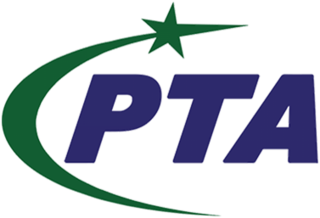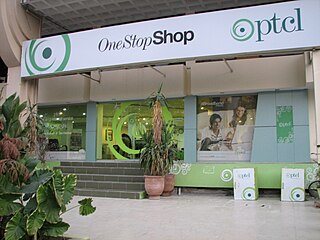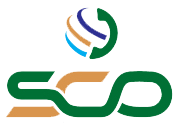Related Research Articles
Telecommunications in the Dominican Republic include radio, television, fixed and mobile telephones, and the Internet.
Nepal's telecommunication network has increased over the years significantly, with the number of telephone users reaching 40,789,198 subscribers as of 14 May 2019.
Telecommunications in Pakistan describes the overall environment for the mobile telecommunications, telephone, and Internet markets in Pakistan.
The liberalization of Bangladesh's telecommunications sector began with small steps in 1989 with the issuance of a license to a private operator for the provision of inter alia cellular mobile services to compete with Bangladesh Telegraph and Telephone Board (BTTB), the previous monopoly provider of telecommunications services within Bangladesh. Significant changes in the number of fixed and mobile services deployed in Bangladesh occurred in the late 1990s and the number of services in operation has subsequently grown exponentially in the past five years.
Pak Telecommunication Mobile Limited or Ufone is a Pakistani GSM cellular service provider. It is the third mobile operator to enter Pakistani market. It started its operations under the brand Ufone, in Islamabad on January 29, 2001.

Mobilink was the trade name of Pakistan Mobile Communications Limited (PMCL), a mobile operator in Pakistan providing a range of prepaid and postpaid voice and data telecommunication services to both individual and corporate subscribers. In 2017, Warid Pakistan merged with Mobilink to form Jazz, under which the company now operates. Mobilink's head office was in Islamabad, and its last president and CEO was Aamir Ibrahim, who became the CEO of Jazz.

The Pakistan Telecommunication Authority (PTA) (Urdu: مقتدرہِ ٹیلی مواصلات پاکستان) is the telecommunication regulator of Pakistan, responsible for the establishment, operation and maintenance of telecommunication systems and the provision of telecommunication services in Pakistan. Headquartered in Islamabad, PTA also has regional offices located in Karachi, Lahore, Peshawar, Quetta, Muzaffarabad, Rawalpindi, Multan and Gilgit.

Telenor Pakistan (Pvt.) Limited is a Pakistani wireless network operator headquartered in Islamabad, Pakistan. Khurrum Ashfaque is the current chief executive officer (CEO).

Pakistan Telecommunication Company Ltd., commonly known as PTCL is the national telecommunication company in Pakistan. PTCL provides telephone and internet services nationwide and is the backbone for the country's telecommunication infrastructure. The corporation manages and operates around 2000 telephone exchanges across the country, providing the largest fixed-line network. Data and backbone services such as GSM, HSPA+, CDMA, LTE, broadband internet, IPTV, and wholesale are an increasing part of its business.

The Internet in South Africa, one of the most technologically resourced countries on the African continent, is expanding. The internet country code top-level domain (ccTLD) .za is managed and regulated by the .za Domain Name Authority (.ZADNA) and was granted to South Africa by the Internet Corporation for Assigned Names and Numbers (ICANN) in 1990. Over 60% of Internet traffic generated on the African continent originates from South Africa. As of 2020, 41.5 million people were Internet users.
Since its beginnings in 1995, the Internet in Malaysia has become the main platform for free discussion in the country's otherwise tightly controlled media environment. As of Q1 2017, Malaysia had broadband penetration rates of 103.6% and 81.8%.

Mexico has approximately 81 million Internet users representing 70.1% of the population. The country ranks 10 in number of Internet users in the world. Mexico is the country with the most Internet users among Spanish speaking countries and is currently experiencing a huge surge in demand for broadband Internet services. In August 2005, Cisco Systems, said they see Mexico and countries in Latin America as the focal point for growth in coming years. With Mexico being identified as a hypergrowth market for equipment suppliers and receiving the biggest chunk of Cisco's investments. Additionally looking at the historical growth for the period from 2001 to 2005 we see broadband Internet jump from 0.1 subscribers per hundred population to 2.2 subscribers per hundred population, a growth of 2100% in just five years.
Internet usage is notably extensive in Switzerland, with 96% of the population aged between 15 and 88 engaging online in 2021. This figure demonstrates a wide adoption across age demographics, highlighted by the fact that over half of those aged 75 and above are daily internet users. The country's advanced broadband infrastructure plays a key role in facilitating this level of usage. By the end of 2022, Switzerland was ranked highest in broadband penetration among the countries of the Organisation for Economic Co-operation and Development (OECD).
Broadband Internet in Israel has been available since the late 1990s in theory, but it only became practically accessible to most customers in 2001. By 2008, Israel had become one of the few countries with developed broadband capabilities across two types of infrastructure—cable and DSL—reaching over 95% of the population. Actual broadband market penetration stands at 77%, ranked 7th in the world. In 2010, Israel was ranked 26th in The Economist's Digital Economy Rankings. In 2022, Israel was ranked first for digital quality of life by Surfshark.
In Romania, there are 18.8 million connections to the Internet. Romania's country code is .ro. The .eu domain is also used, as it is shared with other European Union member states. There were over 600 000 domains registered under .ro at the end of 2012.

CMPak Limited, doing business under brand name Zong, is a Pakistan based mobile data network operator, owned by China Mobile.

wi-tribe was a Pakistani internet service provider that operated in four major cities; Islamabad, Rawalpindi, Lahore, and Karachi until its license was revoked by Pakistan Telecommunication Authority because of frequent service interruption. As of 2021, the services have not been restored. wi-tribe is the first one in Pakistan to launch LTE-Advanced (4.5G) to users.
3G mobile telephony was relatively slow to be adopted globally. In some instances, 3G networks do not use the same radio frequencies as 2G so mobile operators must build entirely new networks and license entirely new frequencies, especially so to achieve high data transmission rates. Other delays were due to the expenses of upgrading transmission hardware, especially for UMTS, whose deployment required the replacement of most broadcast towers. Due to these issues and difficulties with deployment, many carriers delayed acquisition of these updated capabilities.

The Special Communications Organization (SCO) (Urdu: تنظیم برائے مواصلاتِ مخصوصہ) is Pakistani public sector organization operated by MoIT&T. SCO plays a role in providing telecommunication services in Azad Kashmir and Gilgit Baltistan to almost 1.7 million people, a quarter of the total population.

Pakistan Mobile Communications Limited (PMCL), doing business as Jazz, (Urdu: جاز) is Pakistan's largest mobile network and internet services provider formed by the merger of Mobilink and Warid Pakistan.
References
- ↑ "Telecom Indicators | PTA". www.pta.gov.pk.
- 1 2 "Country's internet penetration stands at 54%". The Express Tribune. 30 July 2021. Retrieved 7 September 2021.
- ↑ "MINISTRY OF INFORMATION TECHNOLOGY & TELECOMMUNICATION". moitt.gov.pk. Retrieved 25 August 2020.
- 1 2 3 4 "Telecom Indicators | PTA". Pakistan Telecommunication Authority. 1 January 2024. Retrieved 10 February 2024.
- 1 2 "List of FLL Operators" (PDF). Pakistan Telecommunication Authority . 3 April 2024. Retrieved 26 April 2024.
- ↑ "Pakistan Country Report", The World Factbook, Central Intelligence Agency, United States, 14 June 2011.
- ↑ "Submarine Cable Landing Stations of Pakistan" (PDF). Pakistan Telecommunication Authority. 6 October 2023. Retrieved 10 February 2024.
- ↑ "SEA-ME-WE 6 - Submarine Networks". www.submarinenetworks.com. Retrieved 10 February 2024.
- ↑ Hassan, Taimoor (10 March 2024). "Is PTCL throttling one of its competitors through anticompetitive practices?". Profit by Pakistan Today. Retrieved 17 March 2024.
- ↑ Attaa, Aamir (28 May 2013). "Link Dot Net Wraps up its Broadband Operations in Pakistan". ProPakistani. Retrieved 17 March 2024.
- ↑ Ahmadani, Ahmad (28 February 2021). "Why is Pakistan's internet so slow?". Profit by Pakistan Today. Retrieved 19 September 2023.
- ↑ Gardezi, Ahsan (20 February 2024). "PTA Asks Nayatel, PTCL, Zong and Telenor to Resolve Bandwidth Dispute Within 3 Days". ProPakistani. Retrieved 22 February 2024.
- ↑ Siraj, Wahaj (21 February 2024). "Might tries to be right, Internet is no exception". www.linkedin.com. Retrieved 22 February 2024.
- ↑ "Broadband subscriptions reach 100m in Pakistan". Dawn. 3 April 2021.
- ↑ "Zong 4G - Achieving a Digitally Connected and Innovative Pakistan". 19 January 2022. Retrieved 3 August 2022.
- ↑ "Media Center Detail Jazz Super 4g Upgrades Technology With L900 To Become An Even Faster Mobile Network - Jazz". jazz.com.pk. Retrieved 3 August 2022.
- ↑ "Telenor Pakistan launches LTE-A network". telegeography.com. Retrieved 3 August 2022.
- ↑ "Pakistan becomes first South Asian country to test 5G services". 22 August 2019.
- ↑ "Zong successfully test 5G in Pakistan". Business Recorder . 22 August 2019.
- ↑ "'Pakistan on short list of 5G-ready countries with Zong's successful trial'". Dawn . 22 August 2019.
- ↑ "Urdu on the internet", Ammara Khan, Spider Magazine, reprinted by Dawn News, 29 August 2012.
- ↑ "PTA Annual Report 2018-19".
- ↑ "The eCommerce market in Pakistan". e-commerce database. Retrieved 15 October 2021.
- ↑ "A Look Into Pakistan's E-Commerce Industry". Pakwm. 17 April 2020. Retrieved 29 October 2021.
- ↑ "Pakistan the next frontier for entrepreneurs and investors". TechinAsia. 23 April 2013.
- ↑ MoITT. "Digital Pakistan Policy" (PDF).